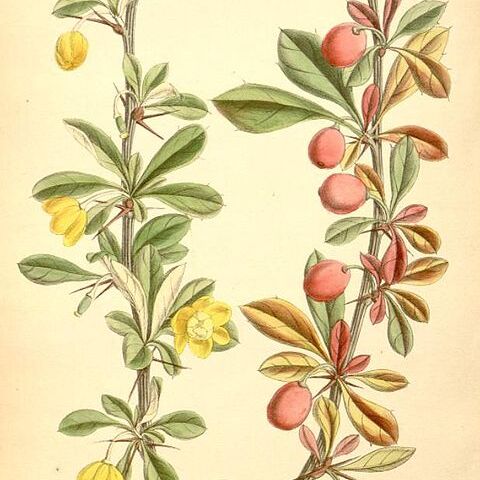Shrubs, deciduous, to 2 m tall. Branches dark brown, pubescent, sulcate; shoots yellow-brown, puberulous; spines simple or 3(or 5)-fid, 7-12 mm, slender, rarely puberulous. Leaf blade abaxially shiny, pale yellow-green, adaxially shiny, yellow-green, obovate, 1.5-2.5 × 0.7-1.4 cm, papery, both surfaces glabrous, inconspicuously veined, base cuneate, margin entire, apex obtuse or acute. Flowers solitary. Pedicels pendulous, 3-5 mm, pubescent; bracteoles ovate, ca. 3.5 × 2 mm, apex acuminate. Sepals in 2 whorls; outer sepals elliptic, ca. 5.5 × 3.5 mm; inner sepals obovate, ca. 9.2 × 6.1 mm. Petals obovate, ca. 6 × 4.8 mm, base clawed, glands separate and oblong, apex entire, rounded. Stamens ca. 4 mm; anther connective slightly prolonged, rounded. Ovules 6, subsessile. Berry shiny, red, subglobose, 10-12 × 9-12 mm, not pruinose, style persistent or not. Fl. May-Jun, fr. Jul-Aug.
More
A shrub. It grows 1-1.3 m high. The leaves turn golden red in autumn. The flowers and fruit are the largest of the Barberries in the Himalayas. The flowers are yellow and in clusters 2 cm long. The fruit are 1.2 cm across. They are a shiny red colour.
Alpine regions, open places in forests and amongst rocks in river beds to 4,500 metres. Sparse forests, thickets and grasslands; at elevations from 3,500-4,500 metres in China. Dry open rocky places in Nepal.
More
It is a temperate plant. It can grow in full sun or light shade. It grows between 3500-4,200 m altitude.
Can be grown by cuttings or seedlings. Seeds needs stratification.

